Table of contents
- Kawasaki tricycle patent is reminiscent of Concept-J From sci-fi to series?
- Construction allows for a low center of gravity
- No variable track width like Concept-J
- Conclusion
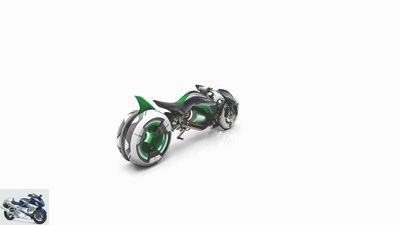
Kawasaki
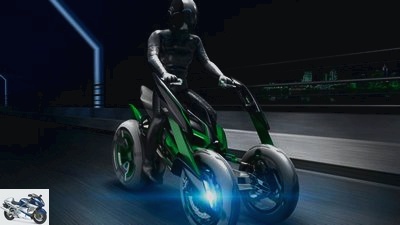

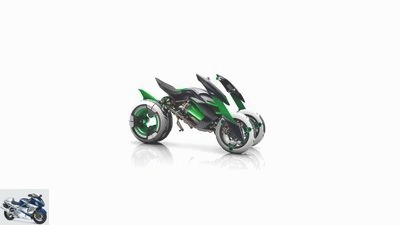

10 pictures
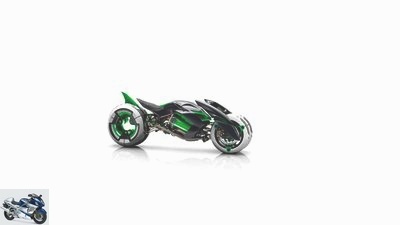
Kawasaki
1/10
In this Kawasaki three-wheel patent, the two front wheels hang on two swing arms instead of fork legs.
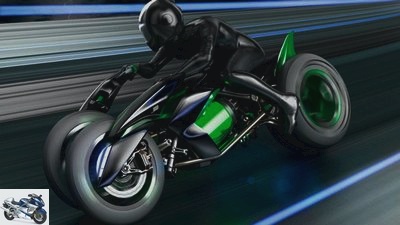
Kawasaki
2/10
At the latest when you look at the two halves of the handlebar, the Concept-J from 2013 drives your mind’s eye.
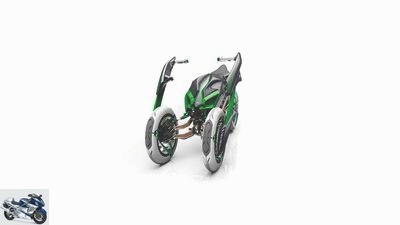
Kawasaki
3/10
Kawasaki presented the Concept-J in 2013.
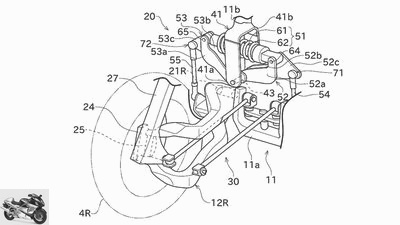
Kawasaki
4/10
The two front swing arms each carry a wheel hub.
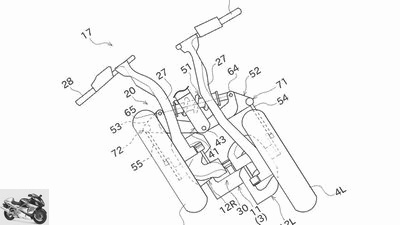
Kawasaki
5/10
Although the two halves of the handlebar are not directly connected to each other, both wheels always have the same steering angle.

Kawasaki
6/10
The variable track width and ergonomics – the most striking thing about the Concept-J study – is not an issue in the design described in the patent.

Kawasaki
7/10
This is what the Concept-J looks like for comfort mode.

Kawasaki
8/10
With a wide front lane for an upright sitting position with a good overview.

Kawasaki
9/10
According to the idea, the Concept-J could be driven much flatter in sport mode.

Kawasaki
10/10
With a narrow track for an aerodynamic seating position for sporty driving.
counselor
technology & future
Kawasaki tricycle patent is reminiscent of Concept-J
Kawasaki tricycle patent is reminiscent of Concept-J
From sci-fi to series?
In 2013, the Kawasaki Concept-J study electrified visitors to the Tokyo Motor Show. Now Kawasaki is getting serious, as this patent specification for the front suspension of a Kawa tricycle shows.
Dina Dervisevic
02/10/2021
At least as far as the front suspension is concerned, parallels to the Concept-J study from 2013 can be seen, because the two front wheels are attached to two swing arms below the two-part handlebar. Each rocker arm carries a wheel hub, with both front wheels sharing a single, transverse damper.
Construction allows for a low center of gravity
The damper also acts as a link between the two suspensions and ensures that the front wheels are in contact with the ground even when cornering. This solution for the front suspension looks simpler and lighter than, for example, the four telescopic fork legs of the Yamaha Niken. With the Yamaha, the center of gravity is very high at the front. A design like the one in the Kawasaki patent drawings could provide a much lower center of gravity.
There shouldn’t be any complaints about indirect feedback from the front with this design, because the two halves of the handlebar are directly connected to the front wheels. So when the motorcycle – or the motorized tricycle – is folded into a left turn, for example, the left handlebar half moves up and the right half moves down. Whether it is on the part Kawasaki will provide a solution to excessive feedback, such as accidentally driving a front wheel through a pothole, is not apparent from these patent drawings.
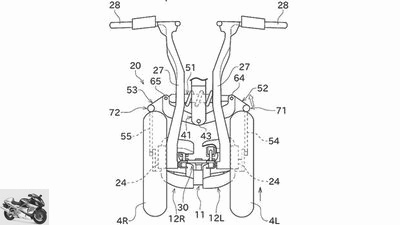
Kawasaki
At the latest when you look at the two halves of the handlebar, the J concept from 2013 comes to mind.
Although the two halves of the handlebar are not directly connected to each other, both wheels always have the same steering angle. This is achieved in that the two halves of the handlebar are each connected to a pivotable linkage via a longitudinal rod, which is mounted below the front shock absorber between the two rockers.
No variable track width like Concept-J
What was particularly striking about the Concept-J study is not shown in this patent specification, namely the variable track width and ergonomics. The idea behind the Concept-J is that, with the front tires further apart, it offers a higher handlebar and a more upright seating position, for example for urban commuter traffic. For the sportier journeys, the front wheels should be able to run close together, the handlebars should be lower and the entire driver should be positioned more sportily.
The chassis shown in the patent pictures is not suitable for such functions. The drawings suggest more of a superbike with a classic combustion engine, although the system for the front suspension could of course also be used for an electric motorcycle.
Conclusion
A low center of gravity – that could be a big plus of this design. How Kawasaki envisions the damping on the handlebars or whether further thinking in the direction of Concept-J – variable track width and geometry – is not clear from the patent specification.
Related articles
-
Patent for tricycle with tilting technology from Kawasaki
Kawasaki 4th pictures Kawasaki 1/4 Kawasaki has a patent for tilting technology with three wheels. The big difference to the previous techniques from…
-
Aprilia tricycle patent: attack on Yamaha Niken?
News 2022 New motorcycle items for 2022 Aprilia 6th pictures Aprilia 1/6 Newly emerged patent drawings show an Aprilia with two front wheels. Aprilia 2/6…
-
Kawasaki adapts Bimota technology: patent for stub axle steering
Kawasaki 6th pictures Kawasaki 1/6 Kawasaki has patented a steering knuckle system. Kawasaki 2/6 The Kawasaki system relies on a single-sided swing arm…
-
Kawasaki patent for curve detection: proactive instead of reactive
Kawasaki counselor technology & future Kawasaki patent for curve detection: proactive instead of reactive Kawasaki patent for curve detection Proactive…
-
Kawasaki patent: semi-automatic and hybrid motorcycle
Kawasaki counselor technology & future Kawasaki patent: semi-automatic and hybrid motorcycle Kawasaki with semi-automatic for hybrid Patent shows…
-
Kawasaki Hybrid patent: E-motor + combustion engine
Kawasaki 3 pictures Kawasaki 1/3 Kawasaki has filed another patent on hybrid motorcycles. Kawasaki 2/3 An electric motor in the transmission could…
-
Driving report: Kawasaki Versys
Kawasaki 16 pictures Kawaski 1/16 Vibration-damping footrests offer the driver more comfort. Kawaski 2/16 Whether black or yellow, the Versys has an…
-
125 tracker: Patent drawings from F.B.Mondial stolen
Aprilia 9 pictures Aprilia 1/9 In November 2020, the following design sketches were registered for patent in China. Aprilia 2/9 A Chinese contract…
-
Aprilia patent: comeback of the anti-dive system
Piaggio Group 7th pictures Piaggio Group 1/7 The Piaggio subsidiary Aprilia has patented a mechanical anti-dive system. Piaggio Group 2/7 A corresponding…
-
Alpenmasters Part 2: 48 hp bikes from Honda, Kawasaki, KTM and Yamaha
fact 22nd pictures fact 1/22 Not a lot of power, but a lot of fire. The 48 hp bikes also competed against each other at this year’s Alpen Masters. fact…